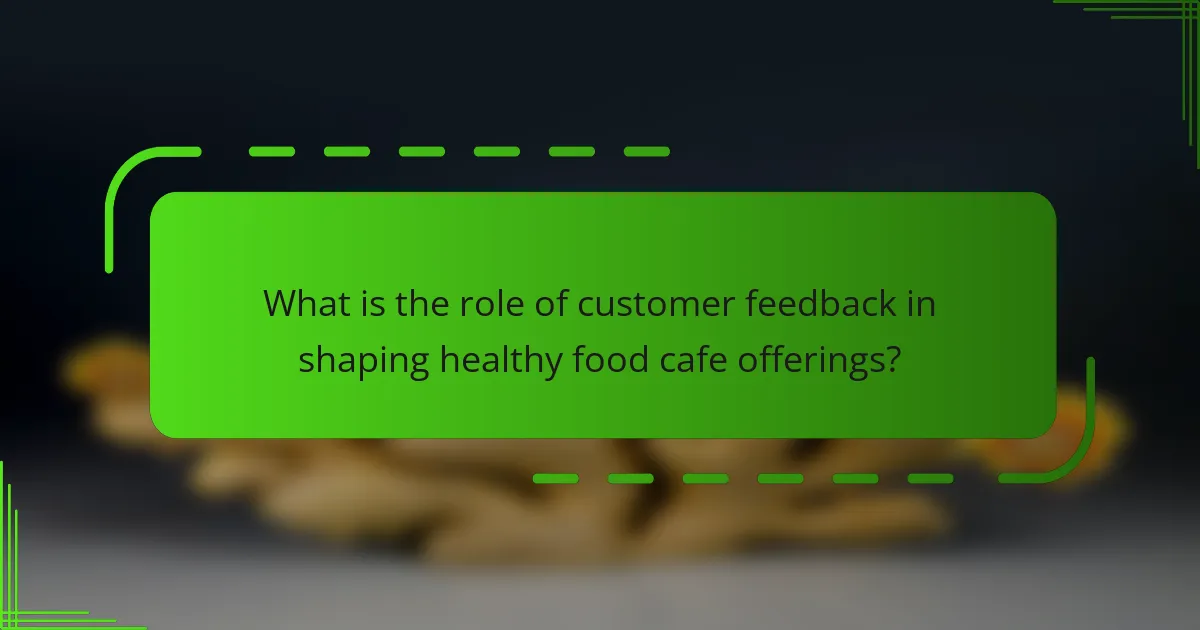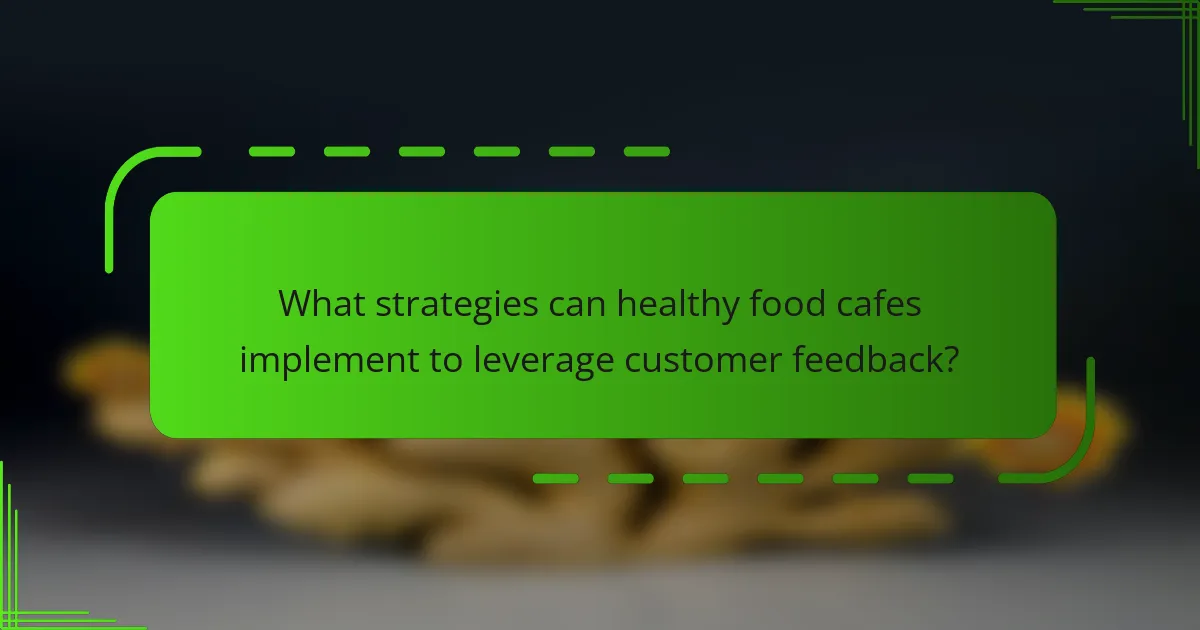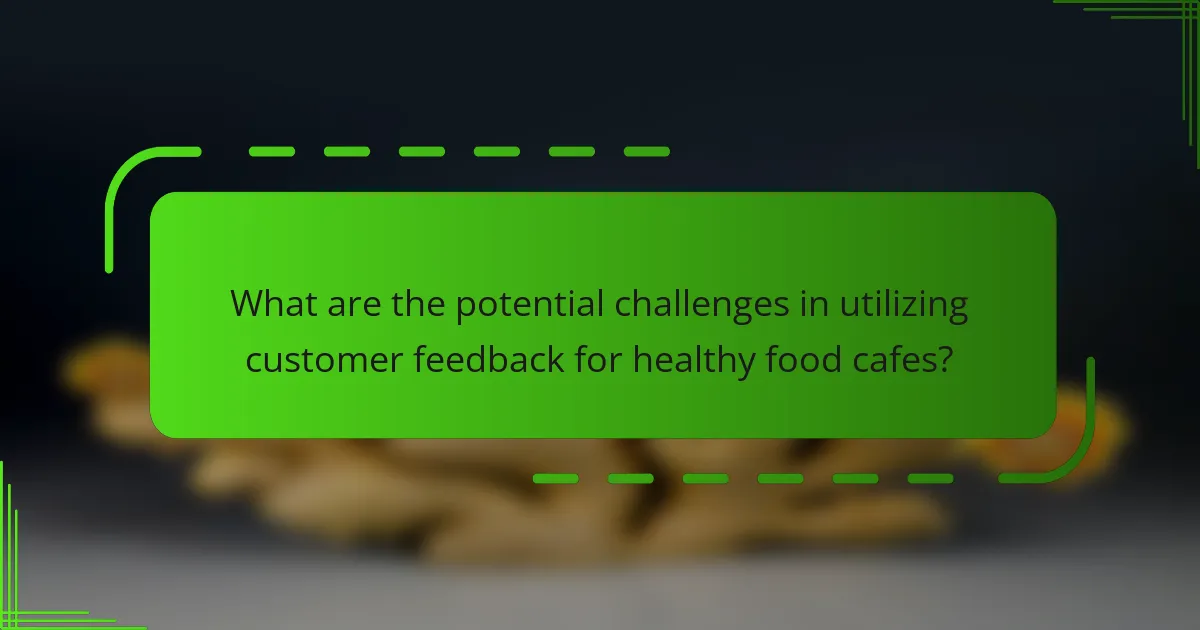Customer feedback is a vital factor in shaping the offerings of healthy food cafes. It provides insights into customer preferences and dietary needs, leading to menu adjustments that enhance satisfaction and loyalty. Strategies for effectively leveraging customer feedback include utilizing surveys, engaging on social media, analyzing online reviews, and hosting focus groups. While challenges such as misinterpretation of feedback and varying customer preferences exist, addressing these can lead to improved offerings and stronger customer relationships. Regular communication about changes made based on feedback fosters trust and encourages ongoing input from customers.

What is the role of customer feedback in shaping healthy food cafe offerings?
Customer feedback plays a crucial role in shaping healthy food cafe offerings. It informs cafes about customer preferences and dietary needs. This feedback can lead to menu adjustments that align with customer tastes. For instance, a survey may reveal a demand for gluten-free options. Consequently, cafes may introduce new dishes to meet this demand. Additionally, feedback helps identify popular ingredients and flavors. This data-driven approach enhances customer satisfaction and loyalty. Research shows that 70% of customers are more likely to return if their feedback is acted upon. Thus, integrating customer feedback is essential for continuous improvement in healthy food cafes.
How does customer feedback influence menu development in healthy food cafes?
Customer feedback directly influences menu development in healthy food cafes by providing insights into customer preferences. Cafes analyze feedback to identify popular dishes and ingredients. This data helps them adjust their offerings to meet customer demand. For instance, if customers request more plant-based options, cafes may expand their vegan menu items. Additionally, feedback highlights areas for improvement, such as taste or presentation. Cafes can refine recipes based on specific suggestions from patrons. Ultimately, incorporating customer feedback fosters a more tailored dining experience. This approach can lead to increased customer satisfaction and loyalty, driving repeat business.
What types of feedback are most valuable for healthy food cafes?
Customer feedback on menu items, service quality, and ambiance is most valuable for healthy food cafes. Menu feedback includes preferences for flavors, ingredients, and portion sizes. Service quality feedback assesses staff friendliness, efficiency, and knowledge of healthy options. Ambiance feedback covers the cafe’s atmosphere, cleanliness, and seating comfort. Research shows that 70% of customers prefer cafes that respond to their feedback. This statistic indicates the importance of listening to customer input to enhance offerings and customer satisfaction.
How can cafes effectively collect customer feedback?
Cafes can effectively collect customer feedback through surveys, comment cards, and digital platforms. Surveys can be distributed after purchases to gauge customer satisfaction. Comment cards placed on tables allow for immediate feedback. Digital platforms like social media and email newsletters can reach a broader audience. Incentives, such as discounts or loyalty points, can encourage participation. Monitoring online reviews also provides valuable insights into customer experiences. According to a 2021 survey by HubSpot, 93% of customers are willing to provide feedback if asked. This highlights the importance of actively seeking customer opinions.
Why is customer feedback essential for the success of healthy food cafes?
Customer feedback is essential for the success of healthy food cafes because it directly influences menu development and customer satisfaction. Healthy food cafes rely on understanding customer preferences and dietary needs. Feedback helps identify popular items and areas for improvement. It allows cafes to adjust their offerings based on real-time customer insights. According to a study by the Harvard Business Review, businesses that actively seek customer feedback can increase their revenue by up to 10%. This demonstrates the financial impact of listening to customers. Moreover, customer feedback fosters loyalty and repeat business. Cafes that engage with their patrons create a sense of community and trust. This ultimately contributes to long-term success and growth.
What impact does customer feedback have on customer satisfaction?
Customer feedback significantly influences customer satisfaction. It provides insights into customer preferences and expectations. By addressing feedback, businesses can improve their offerings. This leads to enhanced customer experiences. Studies show that 70% of customers are more likely to return after their feedback is addressed. Additionally, 54% of customers report increased loyalty when their opinions are valued. Therefore, effectively utilizing customer feedback can directly boost satisfaction levels.
How does feedback contribute to the overall brand image of a healthy food cafe?
Feedback directly influences the overall brand image of a healthy food cafe. Positive feedback enhances the cafe’s reputation and attracts new customers. It demonstrates customer satisfaction and loyalty, which are essential for brand growth. Negative feedback, when addressed, shows that the cafe values customer opinions and is committed to improvement. This responsiveness can turn dissatisfied customers into advocates. Research indicates that 70% of consumers trust online reviews as much as personal recommendations. A strong online presence with positive reviews can significantly elevate a cafe’s brand image. Consistent feedback helps cafes adapt their offerings to meet customer preferences, further solidifying their brand identity.

What strategies can healthy food cafes implement to leverage customer feedback?
Healthy food cafes can implement several strategies to leverage customer feedback effectively. First, they can use feedback forms or surveys to gather customer opinions directly. This method allows cafes to ask specific questions about menu items and service quality. Secondly, they can engage with customers on social media platforms. This interaction can provide real-time feedback and foster a community around the cafe.
Additionally, cafes can analyze online reviews to identify common themes. This analysis can highlight areas for improvement or successful offerings. They can also establish a loyalty program that encourages customers to provide feedback in exchange for rewards. This strategy not only incentivizes feedback but also builds customer loyalty.
Moreover, hosting focus groups can provide in-depth insights into customer preferences. These discussions can reveal valuable information about new product ideas or service enhancements. Lastly, cafes should regularly communicate changes made based on customer feedback. This transparency can enhance customer trust and encourage ongoing feedback.
How can cafes integrate customer feedback into their operational processes?
Cafes can integrate customer feedback into their operational processes by establishing systematic channels for collecting opinions. These channels may include surveys, comment cards, and digital platforms. Regularly reviewing this feedback allows cafes to identify trends and areas for improvement. Implementing changes based on customer suggestions can enhance menu offerings and service quality. For instance, a study by the National Restaurant Association found that 70% of customers prefer cafes that adapt their menus based on feedback. Training staff to actively listen to customer concerns also fosters a responsive environment. Engaging customers in the decision-making process can lead to increased loyalty and satisfaction.
What tools and technologies can assist in gathering and analyzing feedback?
Survey tools like SurveyMonkey and Google Forms enable efficient feedback collection. These platforms allow users to create customized questionnaires. They can analyze responses in real-time. Analytics tools like Tableau and Google Data Studio help visualize feedback data. These technologies assist in identifying trends and patterns. Social media monitoring tools like Hootsuite track customer sentiment. They gather insights from platforms like Twitter and Facebook. Customer relationship management (CRM) systems, such as Salesforce, store feedback data. They facilitate analysis alongside customer interactions. Together, these tools provide a comprehensive approach to feedback analysis.
How can cafes train staff to respond to customer feedback effectively?
Cafes can train staff to respond to customer feedback effectively through structured training programs. These programs should include role-playing scenarios that simulate customer interactions. Staff should learn active listening techniques to understand customer concerns fully. Providing clear guidelines on how to handle different types of feedback is essential. Regular workshops can reinforce these skills and keep staff updated. Additionally, cafes should encourage a culture of open communication. This fosters an environment where staff feel comfortable addressing feedback. Implementing a feedback tracking system can help staff learn from past interactions. This approach leads to continuous improvement in service quality.
What are the best practices for responding to customer feedback?
Best practices for responding to customer feedback include acknowledging the feedback promptly. Timely responses show customers that their opinions are valued. Personalizing responses enhances customer connection. Address specific concerns raised in the feedback. This demonstrates attention to detail and genuine care. Offering solutions or improvements can turn negative experiences into positive ones. Following up after resolving issues reinforces customer loyalty. Encouraging further feedback creates an ongoing dialogue. Research indicates that businesses that actively engage with customer feedback see a 10% increase in customer satisfaction (Source: “Customer Feedback Management: A Comprehensive Guide,” 2021, by Smith & Johnson).
How should cafes prioritize feedback to make impactful changes?
Cafes should prioritize feedback by categorizing it based on urgency and impact. They can start by collecting feedback through surveys and direct interactions. Next, they should analyze this feedback to identify common themes. High-frequency issues should be addressed first, as they affect more customers. Additionally, cafes should consider the potential benefits of each change. Implementing changes that enhance customer satisfaction can lead to increased loyalty. For example, a study by the Harvard Business Review found that businesses responding to customer feedback saw a 10-15% increase in customer retention. Regularly reviewing and adjusting based on feedback ensures continuous improvement.
What role does transparency play in addressing customer concerns?
Transparency plays a crucial role in addressing customer concerns. It fosters trust between customers and businesses. When customers receive clear information, they feel more secure in their choices. Transparency allows businesses to openly share their practices, ingredients, and sourcing. This openness can significantly reduce customer anxiety about food safety and quality. Research indicates that 86% of consumers consider transparency important when making food choices. Providing detailed information can lead to increased customer satisfaction and loyalty. Ultimately, transparency helps businesses respond effectively to customer inquiries and complaints.

What are the potential challenges in utilizing customer feedback for healthy food cafes?
The potential challenges in utilizing customer feedback for healthy food cafes include misinterpretation of feedback, varying customer preferences, and data overload. Misinterpretation can lead to incorrect conclusions about what customers want. Healthy food cafes often attract diverse clientele with differing tastes and dietary needs. This variance can complicate the feedback analysis process. Additionally, cafes may receive an overwhelming amount of feedback, making it difficult to identify actionable insights. Limited resources can hinder the ability to analyze and implement changes based on feedback. Furthermore, negative feedback can disproportionately affect staff morale and decision-making. Lastly, customer feedback may not always align with business goals, leading to conflicts in prioritization.
How can cafes overcome negative feedback?
Cafes can overcome negative feedback by actively addressing customer concerns. They should respond promptly to negative reviews. Acknowledging the issue shows customers that their opinions matter. Offering solutions or compensation can help rebuild trust. Implementing changes based on feedback demonstrates commitment to improvement. Regularly soliciting customer opinions can prevent future issues. Training staff to handle complaints effectively is crucial. Research shows that 70% of customers are willing to return if their issue is resolved quickly.
What strategies can be employed to turn negative feedback into positive outcomes?
A key strategy to turn negative feedback into positive outcomes is to actively listen to customers. Listening allows cafes to understand specific concerns and areas for improvement. Another effective strategy is to respond promptly and empathetically to feedback. This shows customers that their opinions are valued. Implementing changes based on feedback can also create positive outcomes. For example, if customers express dissatisfaction with a menu item, revising that item can enhance customer satisfaction. Additionally, following up with customers after changes can reinforce their importance to the business. Research indicates that businesses that address negative feedback can improve customer loyalty by up to 70%. Engaging customers in the solution process can foster a sense of community and ownership. Overall, these strategies not only mitigate negative experiences but also build stronger relationships with customers.
How can cafes manage conflicting feedback from different customers?
Cafes can manage conflicting feedback from different customers by actively listening and categorizing the feedback. They should identify common themes in the feedback to understand the underlying issues. Implementing a feedback management system can help track and analyze customer comments effectively.
Staff training on handling customer feedback is essential for consistent responses. Engaging with customers through surveys can provide insights into their preferences. Offering personalized responses to feedback shows customers that their opinions matter.
Creating a transparent communication channel allows customers to see how their feedback influences changes. According to a study published in the Journal of Consumer Research, businesses that respond to feedback effectively can increase customer loyalty.
What are some common misconceptions about customer feedback in the food industry?
One common misconception about customer feedback in the food industry is that it only reflects negative experiences. Many believe that customers only provide feedback when they are dissatisfied. However, research shows that positive feedback is also prevalent. According to a study by the Harvard Business Review, satisfied customers are 12 times more likely to leave positive reviews. Another misconception is that feedback is only relevant for large chains. In reality, small businesses benefit significantly from customer insights as well. Feedback helps them improve offerings and enhance customer loyalty. Additionally, some think that feedback is only useful for product development. In truth, it also informs marketing strategies and customer service improvements.
Why do some cafes underestimate the power of customer feedback?
Some cafes underestimate the power of customer feedback due to a lack of understanding of its impact. Many cafe owners believe that their personal taste or vision is more important than customer opinions. This can lead to dismissing valuable insights that could enhance their offerings. Research indicates that businesses that actively seek and respond to customer feedback see a 10-15% increase in customer satisfaction. Ignoring feedback can result in missed opportunities for improvement and innovation.
What myths exist regarding the effectiveness of feedback in menu changes?
One myth regarding the effectiveness of feedback in menu changes is that all customer feedback is equally valuable. In reality, feedback can vary significantly in quality and relevance. Another myth is that immediate changes based on feedback will always lead to increased customer satisfaction. Research shows that thoughtful analysis and implementation of feedback over time yield better results. Additionally, some believe that negative feedback should be prioritized over positive feedback. However, positive feedback can also highlight successful elements that should be retained. Lastly, there is a misconception that feedback from a small group of vocal customers represents the views of the entire customer base. Comprehensive data collection and analysis are essential for accurate representation.
What practical tips can healthy food cafes follow to optimize customer feedback utilization?
Healthy food cafes can optimize customer feedback utilization by implementing structured feedback systems. First, they should create multiple channels for feedback collection, such as surveys, comment cards, and digital platforms. This allows customers to express their opinions easily. Second, cafes should analyze feedback regularly to identify trends and common issues. Utilizing data analytics tools can enhance this process.
Third, cafes can encourage customer engagement by responding to feedback promptly. Acknowledging customer input fosters loyalty and trust. Fourth, they should involve staff in the feedback process. Training employees to understand customer feedback can improve service quality.
Fifth, cafes can test changes based on feedback in small batches. This approach minimizes risk while assessing customer reactions. Lastly, sharing updates about changes made from feedback can demonstrate that customer opinions are valued. This transparency can enhance customer satisfaction and retention.
The main entity of the article is customer feedback in the context of healthy food cafes. The article explores how customer feedback influences menu development, enhances customer satisfaction, and shapes the overall brand image of healthy food cafes. It discusses valuable types of feedback, effective collection methods, and strategies for integrating feedback into operational processes. Additionally, it highlights the importance of transparency and addresses common challenges and misconceptions related to utilizing customer feedback. The article emphasizes that leveraging customer insights can lead to improved offerings and increased loyalty in the competitive landscape of healthy food cafes.